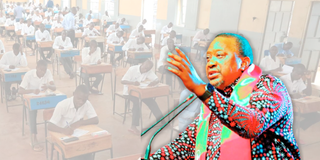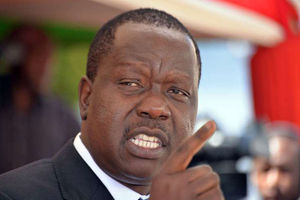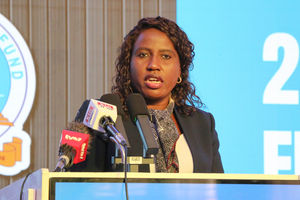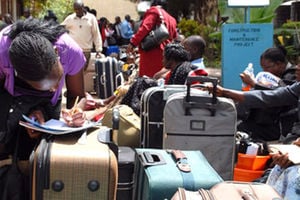
The examination waiver was introduced by President Uhuru Kenyatta in 2015 for all public school learners and was extended to private school learners in 2017.
Parents will from next year pay examination fees for their children, effectively bringing to an end the fees waiver that candidates have enjoyed since it was introduced 10 years ago.
The government will only pay examination fees for candidates who will be considered needy through a means testing plan that mirrors the controversial higher education funding model that was introduced in 2023.
If implemented, parents will now pay for the cost of Kenya Primary School Education Assessment (KPSEA), the Kenya Junior School Education Assessment (KJSEA) and the Kenya Certificate of Secondary Education (KCSE) examinations. The tests are all administered by the Kenya National Examinations Council (Knec).
The Cabinet Secretary for National Treasury and Economic Planning John Mbadi told the Nation in an exclusive interview that the government will adopt a targeted subsidy model that will only benefit learners who will be deemed unable to afford the cost of examinations.
He, however, did not elaborate how the needy status of the learners would be determined.
“The Ministry of Education must come up with criteria of identifying those who can pay examination fees. For example, if your child is learning in a private school where you pay Sh300,000 (per term) or Sh1 million in a year, honestly, can't you pay Sh5,000 examination fees for that child? Why should you force taxpayers, some of whom can barely make a living, to pay examination fees for your child?” said Mr Mbadi in an interview at his office.
The examination waiver was introduced by then President Uhuru Kenyatta in 2015 for all learners in public schools and extended to those in private schools in 2017.
The waiver was intended to ensure all learners sit the national examinations and facilitate the 100 per cent transition policy.
At its inception, the government allocated Sh4 billion to cater for the cost of examinations but for the last two years has allocated Sh5 billion.
At the time, candidates for the now phased-out Kenya Certificate of Primary Education (KCPE) examinations used to pay Sh800 while those who sat the Kenya Certificate of Secondary Education (KCSE) examinations paid a basic fee of Sh2,700 and Sh400 per subject.
The proposed plan is therefore a major policy shift from the current arrangement of universal fee waiver that ensures all candidates in both public and private schools sit their tests without cost.
Mr Mbadi said the decision was anchored on the need for fiscal responsibility and fairness in how taxpayers’ money is spent.
He dismissed reports that the National Treasury has not allocated any funds for this year’s examinations.
The CS clarified that there is a budget for this year’s national examinations and that the Cabinet had already approved the procurement.
“There will be a procedure of providing for that money. So there should be no worry. The parents should not panic,” Mr Mbadi said.
He then said that from next year, all learners will not be guaranteed of government support.
Knec has in recent years been struggling to pay the officials it contracts during the examination season due to inadequate funding from the government as candidature has significantly increased over the 10 years the waiver has been in use.
“We have to review the cost in the sense that we must ask ourselves, why should we pay examination fees for all students, including those who are in private schools? We should be subsidising examination [fees] for those who cannot afford,” said Mr Mbadi.
Since 2015, the government has footed the bill for the KCPE and KCSE examinations, and, more recently, the various assessments under the competency-based curriculum (CBC), easing the burden on households amid rising costs of living.
The CEO of Knec, Dr David Njeng’ere, told the Nation that the council has been making a case for per capita allocation of examination fees instead of the grant system where the organisation is given a general figure, irrespective of the number of candidates registered.
“Per capita funding would solve the problem. We never had problems prior to 2015 when candidates used to pay individually. We’re four months to the exams and we still don’t have money,” he said.
This comes at a time when the number of candidates exiting each level of the education system is steadily increasing.
In 2026, the Ministry of Education projects that over three million learners will sit for the KCSE, KPSEA and the KJSEA.
However, Mr Silas Obuhatsa, the chairperson of the National Parents Association, expressed concern about the decision and called for public participation before the policy change is operationalised.
“We thank the government for raising funds for this year’s examinations. There was widespread concern among stakeholders about the absence of a clear budget, so we appreciate the clarification. However, going forward, it is important that parents are involved at the early stages of such critical decisions. Public participation must be prioritised, and parents should be given an opportunity to air their concerns,” he said.
Mr Obuhatsa compared the proposed plan to the funding model for higher education, which has hit headwinds and is subject of a court case.
“If we compare this with the new university funding model, we can see how long it took to implement – and even now, it’s still facing challenges. How will the government, particularly at the basic education level, accurately determine who can and cannot afford to pay exam fees? Even in private schools, some students are there on sponsorships,” he said.
“This policy shift could become a major problem for parents. Some may be forced to withdraw their children from school, which could result in increased dropout rates, especially among vulnerable learners.”
The examination subsidy plan Mr Mbadi proposed closely mirrors the controversial university funding model unveiled in 2023, which also sought to move away from blanket government funding to a needs-based approach.
The model introduced a four-tier system classifying students as vulnerable, extremely needy, needy, or less needy; each receiving different levels of support.
But implementation has been riddled with problems, from delayed disbursements to confusion over eligibility.
The plan has since faced legal challenges and criticism, leaving thousands of students to pay for their education out of pocket.








